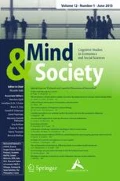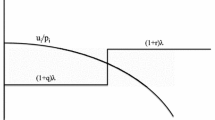Abstract
We study complex phenomena arising from a simple optimal choice consumer model, starting from the classical framework in Benhabib and Day (Rev Econ Stud 48(3):459–471, 1981). We introduce elements of increasing complexity (dynamic adjustment processes, nonlinear social interdependence, agents heterogeneity, agents local interaction) and we investigate their effects on the resulting social behaviors. The dynamics introduce the dependence of current preferences on past consumers actions. A non-monotone updating preference function allows us to obtain a threshold effect, according to which the agents adopt a bandwagon/snob behavior if the preferences are below/above a certain saturation level. We consider homogeneous and heterogeneous agents and we introduce local/global interaction when they are spatially distributed. We show through simulations several phenomena which are absent in the classical model and which reproduce significant social behaviors, such as path dependence, coexistence of different periodic and chaotic attractors, emergence of spatial patterns.




Similar content being viewed by others
References
Arthur WB (1994) Increasing returns and path dependence in the economy. University of Michigan Press, Ann Arbor
Bell AM (2002) Locally interdependent preferences in a general equilibrium environment. J Econ Behav Organ 47:309–333
Benhabib J, Day RH (1981) Rational choice and erratic behavior. Rev Econ Stud 48(3):459–471
Di Giovinazzo V, Naimzada A (2015) A model of fashion: endogenous preferences in social interactions. Econ Model 47:12–17
Granovetter M (1978) Threshold models of collective behavior. Am J Sociol 83:489–515
Kvasnička M (2012) Markets, social networks, and endogenous preferences. In: Ramík J, Stavárek D (eds) Proceedings of 30th international conference mathematical methods in economics. Silesian University, School of Business Administration, pp 518–523
Naimzada A, Tramontana F (2009) Interdependent preferences. Lect Notes Econ Math Syst 613:127–142
Patidar V (2006) Co-existence of regular and chaotic motions in the Gaussian map. Electron J Theor Phys 3(13):29–40
Simmel G (1904, reprint 1957) Fashion. Am J Sociol. 62(6):541–558
Author information
Authors and Affiliations
Corresponding author
Rights and permissions
About this article
Cite this article
Cavalli, F., Naimzada, A. & Pireddu, M. Emergence of complex social behaviors from the canonical consumption model. Mind Soc 15, 71–81 (2016). https://doi.org/10.1007/s11299-015-0169-9
Received:
Accepted:
Published:
Issue Date:
DOI: https://doi.org/10.1007/s11299-015-0169-9




